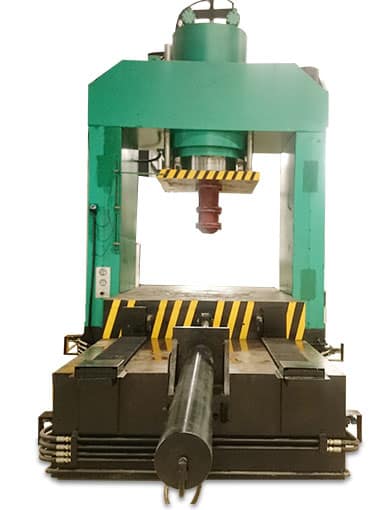How to Make Home Hydraulic Press
time:2023-07-28 views:(点击 752 次)Hydraulic presses are essential pieces of equipment in any garage or workshop, and in this article we'll take a look at its main features and benefits.
Hydraulic presses are highly flexible machines, offering both independent workers and large manufacturers numerous advantages. Composed of a steel frame containing a hydraulic cylinder controlled by either a manual or electric pump, hydraulic presses offer multiple uses in everyday work life.
1. Hydraulic jack
The hydraulic press (also referred to as a "ram or bottle jack") is an engineering tool commonly used in metalworking to crush, straighten and mold metal. Similar to levers, instead of pushing and pulling an arm like with screw jacks it presses down onto a platen with an integrated hydraulic cylinder pressing against its surface while building pressure as you go.
Create your own home hydraulic press by using an industrial hydraulic ram or truck jack of similar size as what would be found in a machine shop. Look at automotive junkyards, garage sales or online industrial equipment outlets to locate one.
Before attempting to construct your own hydraulic jack at home, it is crucial that you understand its inner workings. At its core lies two cylindrical pieces - one known as the man and another as a piston. Both feature pumping valves which supply hydraulic fluid through hoses to lift up ram, using Pascal's Law (piston area x pressure). There is also a release valve so the load can be lowered again by retracting the ram back down.
There are various kinds of hydraulic jacks on the market, ranging from small bottle jacks to larger models designed to grip steel cables strand jacks can lift several tons and are commonly seen on construction projects.
Some hydraulic jacks feature fittings for pressure gauges, making it easy to monitor exactly what kind of pressure your operating at. This feature can be especially beneficial when working on heavier loads and need to ensure they don't over-extend their ram.
2. Hydraulic pump
Hydraulic presses are indispensable tools in any workshop, capable of exerting thousands of pounds of force for various uses such as metal forming. While purchasing one can be expensive, DIY options exist at lower costs that allow users to build one themselves at much less expense - just ensure you fully understand any safety considerations before beginning to assemble their own hydraulic press!
Hydraulic presses work by compressing hydraulic fluid between two interconnected cylinders: the plunger and ram cylinders (comprising plunger and ram). When applied force is applied to either of these, this compression pressure increases significantly due to piston action in both units and can easily crush objects.
Maintaining an effective hydraulic press requires regular maintenance to keep its pressure at an acceptable level and avoid accidents. An oil leak, caused by malfunctioning equipment or loose connections or misuse, is one of the primary concerns. Leakage may damage both machine components as well as present a serious fire hazard.
Overheating can also be caused by poor ventilation or poorly sealed joints, so to reduce it use an appropriate amount of hydraulic oil at a stable temperature to use. To protect against overheating it is also wise to utilize proper ventilation techniques as this will also help.
Additionally, when operating the press you should always wear work gloves and eye protection. In case of emergency it would also be wise to keep a fire extinguisher handy; and finally it would be wiser if welding jobs were left for professionals or simply bolted connections were utilized instead.
3. Hydraulic cylinder
Hydraulic presses produce immense forces that are used to cut, bend, punch, coin, shear and draw metal into various shapes and forms. They are widely used for metalworking purposes in both industrial settings as well as at home workshop benches.
Hydraulic cylinders operate under Pascal's law, which states that pressure in closed systems remains constant, thus increasing mechanical force when more area of cylinder is exposed to it. Before using one for any task, its working pressure must first be determined using diameter measurements followed by using an online pressure-to-cylinder ratio calculator to gauge how much force will be generated from using one.
As well as understanding a cylinder's pressure, it's also essential that you understand its workings. Each cylinder contains a small piston connected to its base; when the hydraulic jack is pumped up, oil from its reservoir enters the main cylinder through an inlet valve and pushes up on this piston intermittently, pushing its center up slowly each time.
Hydraulic presses rely on hydraulic fluid pressure for their pressure, so it's vital that you understand its operation before trying to construct one yourself. Doing so will enable you to avoid making any costly errors which could potentially harm yourself or the equipment being used.
There are different kinds of hydraulic presses, each offering its own set of advantages and disadvantages. For example, C-frame presses tend to be less costly than their H-frame counterparts and are an economical solution for smaller projects; however, their limited strength means they may be unsuitable for handling larger or heavier objects. Therefore, before selecting the ideal hydraulic press for your task it is wise to research all options thoroughly first.
4. Frame
The frame of a hydraulic press serves as the main structure that holds all its parts together, such as an H-frame, C-frame or 4-post structure. It holds together parts like its cylinder as well as making movement of the press easier if your application requires precision or symmetry.
Steel is an ideal material to use when crafting a frame for a hydraulic press, as its sturdy yet reliable nature means it can withstand the high pressures produced by such presses. Furthermore, this lightweight yet rust-proof material makes for easier maneuvering while being corrosion and oxidation free means you won't have to worry about corrosion issues either.
Once you've assembled all the required metal pieces, assemble them to form a press frame. Even without welding equipment available to you, this method can give similar results as welding while taking less time and effort.
Hydraulic presses can be found in many different applications, from making furniture to building cars. They're often cheaper than similar machines and don't produce noise like some alternatives do; plus their easy repair can save money in the long run; not to mention safety features that protect against accidents or injuries that could otherwise arise - making them a fantastic option for both small businesses and independent craftsmen. Magnum Press provides C-frame, two post, four post, gib-guided presses. If this sounds interesting to you then give them a call - they specialize in C-frame, two post, four post presses with safety features that prevent accidents & injuries - why not reach out? They specialize in C-frame, two post, four post presses as well! If this company specializes in C-frame presses
5. Platen
Hydraulic presses are machines used to compress materials and details. They are an invaluable resource for repairing metal components like car frames and engine blocks as well as creating plastic and rubber products in manufacturing industries.
Hydraulic presses consist of a frame with bed, hydraulic cylinder and pump connected by hydraulic lines, with fluid running between these elements to ram. Ram has an adjustable collar to adjust pressure and height as needed and comes equipped with manometer for measuring fluid pressure. There are various models of hydraulic presses on the market from benchtop models suitable for private workshops that can lift up to 15 tons all the way up to floor hydraulic presses that have capacities exceeding 150 tons - each has different benefits for different users.
Based on your needs, you can select a press with various maximum capacities, either one or two cylinders and various beams. Some models feature adjustable stroke controls to shorten or lengthen cycles, and features such as an Adjustable Retract Limit Switch, T-slot die holding capability and water cooling options can further customize it to meet them.
Hydraulic presses can be invaluable additions to any home workshop, particularly if you enjoy crafting new things or repairing older equipment. But before purchasing one, it is important to fully comprehend their function and what benefits it can bring you. This article covers everything related to hydraulic presses: their history, pricing structure, benefits and types as well as how to construct one yourself from scratch.
Link to this article: https://www.ihydraulicpress.com/nsn/4049.html
Hot Articles
-
How to Make Dabs With Hydraulic Press
Hydraulic presses are powerful industrial devices used to compress various materials. When combined with premium rosin plates, these presses can als……
-
How to Make a Small Hydraulic Press
Have you seen videos on YouTube of hydraulic presses crushing items such as bowling balls or soda cans with immense force? They generate great dea……
-
Hydraulic Press Channel – How Much Does the Hydraulic Press You Tube Channel Make?
The Hydraulic Press Channel is a YouTube channel dedicated to crushing things with hydraulic presses. Founded by Finnish workshop owner Lauri Vuohen……
-
Can You Make a Tortilla With a Hydraulic Press?
Hydraulic presses can be an indispensable asset to any kitchen. From creating tortillas to shaping metals, a hydraulic press can serve many import……
-
How to Make Hydraulic Press Machine
A hydraulic press is a machine that utilizes fluid pressure to compress materials. It consists of an oil tank, cylinder and plunger. The cylinder ……
-
How to Make a Coin Using a Hydraulic Press
Hydraulic presses are machines that use hydraulics to produce compressive force. Their operation relies on Pascal’s Law, which states that w……
-
How Much Force in Hydraulic Press?
Have you seen someone using a hydraulic press before? These powerful machines can produce incredible force, making short work of crushing cars or ……
-
How to Make a Hydraulic Cider Press
Hydraulic presses make for fast juicing of larger amounts of fruit, making them an excellent option for established cider or juice producers who w……
Latest News
-
How to Make a Knife Using a Hydraulic Press
For anyone wanting to learn how to make knives using a hydraulic press, the American Bladesmith Society offers this video from journeyman smith Ka……
-
How to Make a Small Hydraulic Press
Have you seen videos on YouTube of hydraulic presses crushing items such as bowling balls or soda cans with immense force? They generate great dea……
-
How to Make a Tabletop Hydraulic Press Yourself
When it comes to pressing projects with force, a hydraulic press can be an invaluable asset in your workshop. However, purchasing one may be expensi……
-
How to Make a Coin Using a Hydraulic Press
Crafting gold and silver coins using a hydraulic press machine can be made much simpler, while simultaneously decreasing noise pollution levels an……
-
How to Make a Powerful Hydraulic Press
Hydraulic presses are extremely versatile machines that can be utilized for an assortment of tasks, from crushing and stamping to stamping, cold e……
-
How to Make a Hydraulic Press for Forging
Forging is the process of using force to shape metal into their desired forms and tolerances. There are various means by which this force is gener……
-
How to Make an Electric Hydraulic Press
A hydraulic press is a large machine that leverages physics to crush objects, using fluid stored in cylindrical cylinders to generate mechanical f……
-
How to Make Dies for Hydraulic Presses
Hydraulic presses are machines that utilize hydraulic fluid to generate and transfer force, using compressed cylinders of hydraulic presses to gen……














































